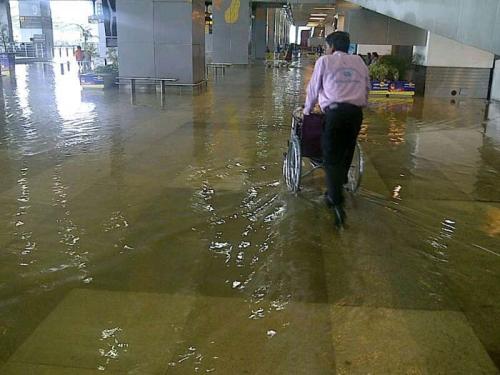A technical article for architects, construction planners, and property developers

Otello Piroddi
M.Sc. Applied Chemistry
AKEMI Application Engineer
Natural stone coverings in high-traffic areas such as airports are aesthetic, durable, and increase property value – when they are properly planned and professionally installed. Particularly robust natural stone types like granite are considered the first choice for such large-scale projects. However, despite high material quality, significant damages often appear shortly after completion: efflorescence, salt deposits, dark water stains, and in some cases even rust damage. What initially seems like a purely visual issue reveals itself upon closer inspection as a building physics oversight.
AKEMI.jpg)
Typical water stain formation at the edge of a granite floor (Photo: AKEMI)
The causes: time pressure and inappropriate installation mortars
The roots of these damages often lie in the construction phase itself. Large projects like airports are under immense time pressure. The installation of natural stone floors is often carried out too early – on still insufficiently dried concrete foundations or screeds. The critical moisture transport from the substrate, which is so important for natural stone, is not adequately considered. At the same time, standard tile adhesives are frequently used, which are not suitable for natural stone installation.
Even temporary protective measures during construction – such as covering finished surfaces with foil, drywall, or tarpaulins – can exacerbate the problem. Trapped moisture cannot escape and causes further visual and structural damage.
AKEMI%20.jpeg)
Efflorescence and crystalline salt deposits caused by premature covering (Photo: AKEMI)
The key lies in the planning phase
To permanently prevent these types of damage, it is essential to consider the protection of natural stone from the very beginning – during the planning phase. Especially crucial is the backside moisture protection of the stone slabs. This prevents capillary rise of moisture and mineral components from the substrate into the stone.
Two protective measures have proven effective in practice:
- Pre-Installation Protection:
A water- or solvent-based impregnation (e.g., AKEMI® Pre-Protect or AKEMI® Protector) is applied to the backside of the stone slabs before installation. When combined with a high-quality natural stone installation mortar of category C2 S1 or C2 S2, it creates an effective temporary moisture barrier. - Two-Component Polymer Coating:
This provides nearly complete barrier protection (e.g., AKEMI® Anti-Stain Coating 2015) against moisture from below. An additional advantage: less high-quality or more affordable mortars can be used, as the protective effect is provided by the coating.
Rust discolouration on granite floor caused by rising moisture (Photo: AKEMI)
Plan ahead instead of correcting later
Incorporating these protective measures into the construction schedule – considering technical, temporal, and especially cost aspects – is crucial. Once damages occur, they are usually difficult to fully repair. Post-construction remediation is often labour-intensive, costly, and rarely satisfactory.
Therefore, planners and developers should early on recognize that backside protection of natural stone slabs is not only sensible but also economically advantageous. Besides choosing the appropriate installation mortar, adhering to the drying times of the substrate is an integral part of a successful installation concept.
Example project: Terminal 3 – Indira Gandhi International Airport, New Delhi
A prime example of proper implementation is Terminal 3 at Delhi’s airport. There, high-quality granite slabs were treated with a solvent-based installation pre-impregnation (AKEMI® Protector) and installed with a specially matched mortar. After installation, an additional protective impregnation (AKEMI® Stain-Repellent Super) was applied to the surface. This combination prevented damage to the natural stone paving even when it was subsequently flooded by monsoon rains – impressive proof of the effectiveness of preventive measures.
|
Flooded Terminal 3 after monsoon rain (Source: www.ndtv.com)
|
Flawless natural stone floor after flooding (Photo: AKEMI)
|
Conclusion:
If you want to sustainably use natural stone in large-scale projects, you must invest in protection early on. Planning for backside moisture protection is not an optional add-on but an essential part of every natural stone installation. The damages caused by moisture problems are irreversible—careful and thoughtful planning is the only way to prevent them.
AKEMI GmbH
Lechstrasse 28 90451 Nuremberg, Germany
Tel. 0911 642960
Fax 0911 644456
June 3, 2025


AKEMI.jpeg)